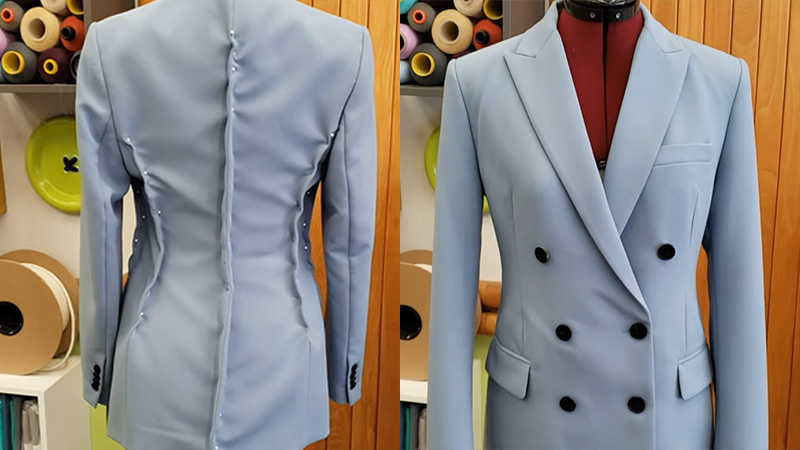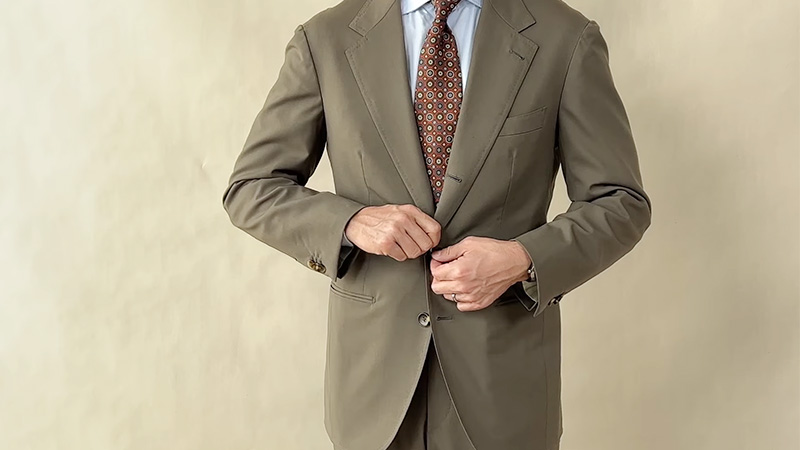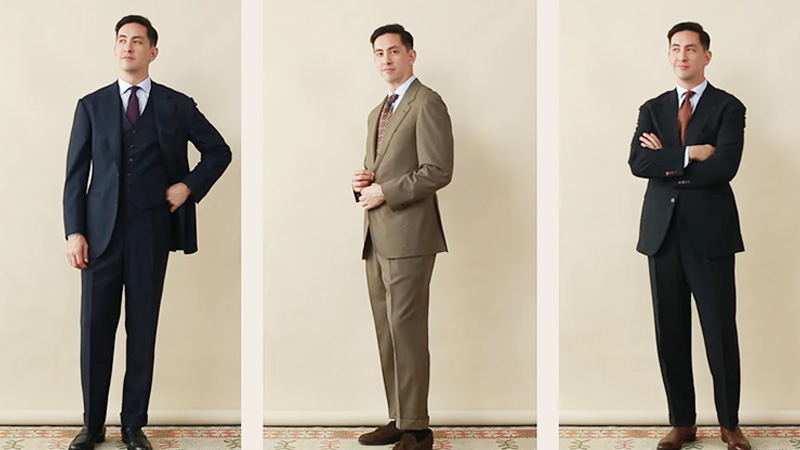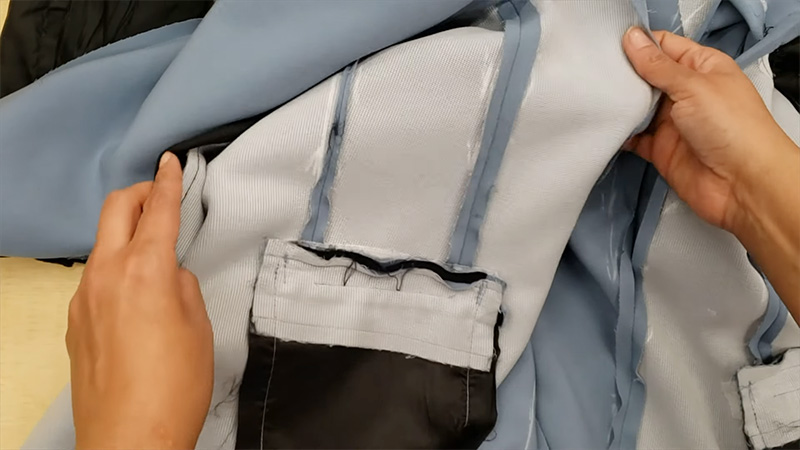The perfect fit is the cornerstone of a polished and confident appearance in fashion. Yet, finding a coat that hugs every contour can be elusive.
Whether it’s a cherished heirloom or a recent addition to the wardrobe, altering a coat that is either too large or small is worth mastering.
This delicate craft marries precision with creativity, transforming an ill-fitting garment into a customized masterpiece.
From careful pinning to meticulous stitching, each step promises a refined, comfortable, and uniquely tailored coat.
The following guide will unravel the steps to achieve this sartorial feat, ensuring your coat embodies both style and comfort.

How to Alter a Coat That Is Too Big or Small?
Altering a coat that is either too big or too small can be a cost-effective and sustainable way to update your wardrobe.
Whether you’ve lost or gained weight, inherited a coat, or found a vintage gem, making it fit perfectly can breathe new life into an otherwise neglected garment.
Here’s a step-by-step guide on how to alter a coat:
Materials You’ll Need:
- Coat in need of alteration
- Seam ripper
- Pins
- Sewing machine or needle and thread
- Fabric chalk or tailor’s pencil
- Measuring tape
- Iron and ironing board
- Scissors
For a Coat that is Too Big:
Try On the Coat
Begin by standing in front of a full-length mirror with good lighting. Take your time to assess how the coat drapes on your body.
Pay close attention to the shoulders, sleeves, torso, and waist. Note if the shoulders are slipping down, if there’s excess fabric around the torso, or if the sleeves are too long. This initial assessment will guide you in pinpointing the areas that need adjustment.
Pin the Excess Fabric
Using straight pins, gently gather the excess fabric along the areas that need alteration. Start at the shoulders and work down, pinning along the seams.
Be meticulous about maintaining a balanced look, ensuring the coat retains its natural shape and symmetry.
Remove Excess Fabric
Lay the coat on a clean, flat surface. With a seam ripper, carefully and methodically undo the stitches along the areas you’ve pinned.
Take your time to avoid stretching or damaging the fabric, especially if it’s delicate or prone to fraying.
Re-sew the Seams
After removing the excess fabric, fold the remaining fabric to the desired size. Pin it in place to ensure it stays secure. Select an appropriate stitch length using a sewing machine and sew along the pinned seams.
For hand-sewing, use a backstitch for added durability. Take care to maintain consistent tension for a professional finish.
Adjust the Lining
If the coat has a lining, carefully align it with the altered outer fabric. Pin it in place and sew along the original seam lines.
This step ensures that the lining and outer fabric sit harmoniously, maintaining the coat’s overall structure and appearance.
Press the Seams
Preheat your iron to a suitable temperature for the fabric. Lay a pressing cloth over the altered areas to protect them from direct heat.
Apply even pressure and glide the iron along the seams, smoothing any wrinkles or creases. This step is instrumental in achieving a polished and professional look.
Trim any Excess Fabric
With sharp scissors, carefully trim any remaining excess fabric. Exercise precision, leaving a small allowance to prevent fraying. Take your time and cut with deliberate movements to achieve clean, neat edges.
Finish with Details
Thoroughly inspect all closures, such as buttons, zippers, or snaps. Make any necessary adjustments to ensure they align perfectly with the new fit.
Also, double-check for strength and durability if any areas were reinforced during the alteration process.
For a Coat that is Too Small:
Assess the Situation
Put on the coat and stand comfortably, allowing yourself to move freely. Please pay close attention to how it feels around the shoulders, arms, chest, and waist.
Take note of any noticeably tight areas. Stand before a mirror to visually assess the fit, ensuring the coat drapes well.
Use Seam Ripper
When the coat has seams that can be let out, carefully and methodically use a seam ripper to undo the stitches.
Work with precision, taking your time to avoid accidentally damaging the fabric. This step allows for additional room in areas where the coat is too snug.
Add Extra Fabric
In cases where letting out seams is not an option, consider adding fabric panels for expansion. Measure the specific areas that require more room and cut matching fabric pieces.
Pin and baste them in place, ensuring a seamless integration with the original fabric. This method provides a tailored solution for achieving a comfortable fit.
Cut and Attach Extra Fabric
Cut the fabric pieces with meticulous care, paying close attention to the grain and pattern matching. Pin them in place and sew with precision.
The objective is to integrate the additional fabric seamlessly, creating a cohesive look that complements the original design.
Adjust the Lining
Since alterations were made to the lining, carefully reattach it. Match the seams with the outer fabric and sew along the original seam lines.
This step is crucial in ensuring that the lining and outer fabric work harmoniously to maintain the coat’s overall structure.
Press the Seams
Preheat your iron and set it to the appropriate temperature. Place a pressing cloth over the fabric to protect it from direct heat.
Gently press along the seams, smoothing out any wrinkles. This process contributes to a refined and well-finished appearance.
Trim any Excess Fabric
Utilize sharp scissors to trim any remaining excess fabric carefully. Exercise precision, leaving a small allowance to prevent fraying. Pay close attention to detail to achieve clean, polished edges.
Finish with Details
Confirm that all closures align correctly with the new fit. Make any necessary adjustments to ensure they function smoothly.
Double-check for strength and durability if any areas were reinforced during the alteration process. This final step ensures that the coat is well-fitted, fully functional, and aesthetically pleasing.
Caring for the Altered Coat

Caring for an altered coat is crucial to maintaining its newly tailored fit and ensuring its longevity.
Here are some essential tips for caring for your altered coat:
Storage
When storing your coat, select a location that is cool, dry, and shielded from direct sunlight. Avoid cramming it into a crowded closet, as this can lead to wrinkling and distortion of the fabric.
Instead, opt for a broad, padded hanger that supports the coat’s shape over time.
Cleaning
Adhere closely to the care instructions indicated on the garment’s label.
If feasible, entrust the cleaning process to a professional dry cleaner, especially if your coat is crafted from delicate or specialty fabrics. Their expertise ensures that your jacket receives the precise care it requires.
Spot Cleaning
If there are minor stains or spills, promptly address them with a gentle fabric spot cleaner. Alternatively, gently create a solution of mild detergent and water to blot the affected area gently with a clean cloth. Avoid vigorous rubbing, which can exacerbate the stain or damage the fabric.
Avoid Over-Washing
Resist the urge to over-wash your coat. Excessive cleaning can lead to unnecessary wear and tear on the fabric.
Only launder the coat when visible dirt or stains are present or after several wears. Consider using a fabric freshener spray to maintain a fresh scent between washes.
Avoid Harsh Chemicals
Exercise caution and refrain from using harsh chemicals such as bleach on your coat. These substances can cause irreversible damage to the fabric and may alter its color or texture.
Instead, opt for gentle, non-abrasive cleaning products designed to preserve the integrity of the fabric.
Proper Drying
Should your coat become wet, allow it to air dry naturally. Avoid exposing it to direct heat sources like radiators or hair dryers, as excessive heat can cause the fabric to shrink or warp.
Ensure the coat is hung or laid out in a well-ventilated area until completely dry.
Avoid Excessive Folding
To prevent the formation of creases and wrinkles, refrain from folding your coat for extended periods.
If circumstances necessitate compact storage, gently drape it over a chair or sturdy hanger. This helps preserve the coat’s original form and structure.
Seasonal Inspection
Before the onset of each new season, thoroughly inspect your coat. Scrutinize for wear and tear, loose seams, or missing buttons.
Addressing these issues promptly prevents them from escalating and preserves the coat’s overall condition.
Avoid Heavy Items in Pockets
Exercise caution when utilizing the pockets of your coat. Refrain from overloading them with heavy items, which places undue stress on the fabric. Distribute the weight evenly to preserve the coat’s fit and comfort.
Troubleshooting Common Issues

Troubleshooting common issues with your coat is essential to maintain its condition and fit.
Here’s a guide on how to address some of the most typical problems:
Uneven Seams
Issue: Occasionally, after alterations, seams may appear uneven or not aligned properly.
Troubleshooting: Carefully inspect the affected seams. If there are discrepancies, consult a professional tailor to reevaluate and correct the seam alignment.
They have the expertise to adjust the seams for a balanced and even appearance.
Loose Threads
Issue: Loose threads may emerge after alterations, particularly around newly sewn seams.
Troubleshooting: Trim any loose threads carefully with sharp scissors, ensuring not to pull on them.
Consider consulting a professional tailor for a more comprehensive inspection and repair if there are extensive loose threads. They can secure any loose ends and reinforce the stitching if needed.
Buttons Coming Loose
Issue: Buttons, snaps, or other fasteners may become loose or fall off.
Troubleshooting: Reattach loose fasteners with a needle and thread. If a fastener is missing, consult a professional tailor for proper replacement and secure attachment. They can ensure the fasteners are firmly in place, preventing future issues.
Fabric Puckering
Issue: Fabric may pucker or gather in places where alterations were made.
Troubleshooting: Press the affected area with an iron on a low heat setting, using a pressing cloth to protect the fabric.
If the puckering persists, consult a professional tailor for further adjustments. They can carefully rework the affected areas to achieve a smoother finish.
Excess Fabric around the Neckline
Issue: After alterations, excess fabric may remain around the neckline or sleeves.
Troubleshooting: Carefully reevaluate the fit around the neckline and sleeves. If excess fabric is still present, consult a professional tailor for further adjustments.
They can assess the fit and make precise alterations to ensure a comfortable and tailored look.
Collar Misalignment
Issue: The collar may appear misaligned or sit awkwardly after alterations.
Troubleshooting: Reassess the collar’s placement and symmetry. Consult a professional tailor for adjustments to ensure a balanced appearance if necessary.
They have the expertise to reposition the collar for a more harmonious fit.
Lining Issues
Issue: The lining may not sit properly or may pull after alterations.
Troubleshooting: Carefully inspect the lining for any tension or misalignment. If issues persist, consult a professional tailor to reevaluate and correct the lining’s placement.
They can make precise adjustments to ensure the lining complements the outer fabric.
Snags or Tears
Issue: Occasionally, alterations may inadvertently lead to snags or tears in the fabric.
Troubleshooting: Depending on the extent of the damage, consult a professional tailor for potential repairs or reinforcement.
They have the expertise to assess the damage and employ specialized techniques to mend snags or tears, ensuring the coat remains in optimal condition.
Fit Changes Over Time
Issue: The coat’s fit may change over time due to wear and laundering.
Troubleshooting: Reassess the fit periodically and consult a professional tailor for any necessary adjustments to maintain the coat’s ideal fit.
They can make subtle alterations to accommodate changes in your body shape or posture, ensuring that the coat continues to fit perfectly.
Color Fading
Issue: Altered coats may experience color fading or discoloration over time.
Troubleshooting: Avoid excessive exposure to sunlight and follow proper cleaning and care guidelines.
If discoloration persists, consult a professional cleaner for advice on color restoration. They have the expertise to assess and address color issues, potentially restoring the coat’s original vibrancy.
When to Consult a Tailor or Seamstress?

Consulting a tailor or sewist can significantly enhance the fit and appearance of your clothing, especially when alterations are required.
Here are some situations when it’s advisable to seek their expertise:
Purchasing New Clothing
Consider consulting a tailor to ensure a perfect fit when buying new garments, especially high-end or formal wear. Tailors can adjust the length, waist, shoulders, and other areas, enhancing the overall look and comfort of the garment.
Altering Off-the-Rack Clothing
When you have off-the-rack clothing that doesn’t fit well, whether it’s too loose, too tight, or needs adjustments in specific areas, a tailor can help.
They can make alterations to improve the fit and style of these garments, making them feel customized.
Weight Loss or Gain
Significant changes in your body size, such as weight loss or gain, often necessitate alterations to your clothing.
Instead of replacing your entire wardrobe, consult a tailor to adjust your existing garments, allowing you to continue wearing them comfortably.
Special Occasions
For weddings, proms, or other special events, it’s advisable to consult a tailor or seamstress.
They can create or adjust formalwear to ensure it’s stylish and fits perfectly, making you look your best on essential occasions.
Repairing Damaged Clothing
A skilled sewist or tailor can mend it professionally when your clothing gets damaged, whether it’s a torn seam, a broken zipper, or a snag.
They can restore your garments to their original condition or even enhance them with creative repairs.
Custom-Made Clothing
Consult a tailor or dressmaker for custom-made garments when you want clothing made to your exact measurements and style preferences.
This option ensures a unique fit and design tailored to your preferences.
Restyling or Upcycling
When you have clothing items you no longer wear due to style changes or fashion trends, a tailor can help restyle or upcycle them into something new and fashionable.
This sustainable approach breathes new life into your existing wardrobe.
Tailoring for Special Needs
Individuals with specific physical needs, such as mobility challenges or sensory sensitivities, may benefit from consulting a tailor or sewist specializing in adaptive clothing.
They can create custom garments that accommodate these unique requirements.
Vintage Clothing Restoration
Vintage clothing often requires careful restoration and alteration to return to wearable condition.
Experienced tailors can work with delicate fabrics and intricate designs to restore vintage pieces to their former glory.
Expert Advice
Consult a tailor or seamstress for expert advice when unsure about the best approach to altering or repairing clothing.
They can guide the feasibility of alterations and recommend solutions that align with your preferences and budget.
FAQs
Can I alter a coat that is too small to fit me comfortably?
Yes, a skilled tailor can make adjustments to expand the coat’s size by letting out seams or adding fabric panels for a more comfortable fit.
What should I do if my coat is too big around the shoulders and sleeves?
You can consult a tailor to adjust the shoulder and sleeve seams carefully, ensuring a more tailored fit without compromising the coat’s overall structure.
Is it possible to shorten the length of a coat that is too long for me?
A tailor can expertly shorten the coat’s length while preserving its original design and proportions.
How do I know if my coat needs alterations or is simply the wrong style for me?
A consultation with a professional tailor is the best way to determine if alterations can enhance the fit and style of your coat.
Can I alter a coat made of delicate or unique fabric?
Yes, a skilled tailor has experience working with various fabrics and can provide specialized care to ensure alterations are made with precision and care, regardless of the material.
Wrap Up
In tailoring, the transformative power lies in precision and expertise. When faced with a coat too big or small, these steps become the guiding hand, ensuring a perfect fit.
The coat is tailored to its wearer’s unique contours through careful pinning, meticulous stitching, and artful adjustments. The marriage of skill and patience gives birth to a garment that adorns and embraces, instilling confidence and comfort.
This process transcends mere alterations; it is a testament to the craft, a symphony of fabric and thread harmonizing with the individual. Ultimately, it’s more than a coat—it’s a tailored masterpiece, a testament to the artistry of customization.
Leave a Reply